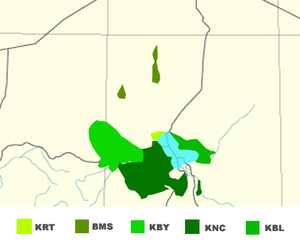Kanuri language
| Kanuri | |
|---|---|
| Native to | Nigeria, Niger, Chad, Cameroon |
| Region | Lake Chad |
| Ethnicity | Kanuri (Yerwa Kanuri etc.), Kanembu |
Native speakers | (4.1 million 10.5 million cited 1986-2015)[1] |
|
Nilo-Saharan?
| |
| Language codes | |
| ISO 639-1 |
kr |
| ISO 639-2 |
kau |
| ISO 639-3 |
kau – inclusive codeIndividual codes: knc – Central Kanurikby – Manga Kanurikrt – Tumari Kanuribms – Bilma Kanurikbl – Kanembu |
| Glottolog |
kanu1279[2] |
| Linguasphere |
02-AAA-a (+Kanembu 02-AAA-b) |
 Map of the majority usage of the five major languages of the Kanuri language group.
| |
Kanuri /kəˈnuːri/[3] is a dialect continuum spoken by some four million people, as of 1987, in Nigeria, Niger, Chad and Cameroon, as well as small minorities in southern Libya and by a diaspora in Sudan. At the turn of the 21st century, its two main dialects, Manga Kanuri and Yerwa Kanuri (also called Beriberi, which its speakers consider to be pejorative), were spoken by 5,700,000 people in Central Africa.[4] It belongs to the Western Saharan subphylum of Nilo-Saharan. Kanuri is the language associated with the Kanem and Bornu empires which dominated the Lake Chad region for a thousand years.
The basic word order of Kanuri sentences is subject–object–verb. It is typologically unusual in simultaneously having postpositions and post-nominal modifiers – for example, "Bintu's pot" would be expressed as nje Bintu-be, "pot Bintu-of".
Kanuri has three tones: high, low, and falling. It has an extensive system of consonantal lenition; for example, sa- "they" + -buma "have eaten" → za-wuna "they have eaten".
Traditionally a local lingua franca, its usage has declined in recent decades. Most first-language speakers speak Hausa or Arabic as a second language.
Geographic distribution
Kanuri is spoken mainly in lowlands of the Chad Basin, with speakers in Cameroon, Chad, Niger, Nigeria and Sudan.
Varieties
Ethnologue divides Kanuri into the following languages, while many linguists (e.g. Cyffer 1998) regard them as dialects of a single language. The first three are spoken by ethnic Kanuri and thought by them as dialects of their language.
- Central Kanuri
- Manga Kanuri
- Tumari Kanuri
- Kanembu
Written Kanuri
Kanuri has been written using the Ajami Arabic script, mainly in religious or court contexts, for at least four hundred years.[5] More recently, it is also sometimes written in a modified Latin script.
Alphabet
A standardized romanized orthography (known as the Standard Kanuri Orthography in Nigeria) was developed by the Kanuri Research Unit and the Kanuri Language Board. Its elaboration, based on the dialect of Maiduguri, was carried out by the Orthography Committee of the Kanuri Language Board, under the Chairmanship of Abba Sadiq, Waziri of Borno. It was officially approved by the Kanuri Language Board in Maiduguri, Nigeria, in 1975.[6]
Letters used : a b c d e ǝ f g h i j k l m n ny o p r ɍ s sh t u w y z.[7]
Pronouns
| Singular | Plural | |
|---|---|---|
| First person | wú, ú | àndí |
| Second person | ní | nàndí, nàyí |
| Third person | tí | tàndí, tàyí |
Sources
- Norbert Cyffer & John P. Hutchison (eds.) Dictionary of the Kanuri Language (Publications in African languages and linguistics, 13). Foris Publications 1990. ISBN 90-6765-412-4.
- Norbert Cyffer, We Learn Kanuri (book and 2 audio cassettes), ISBN 3-927620-01-7, Rüdiger Köppe Verlag: Köln 1993.
- Norbert Cyffer, English-Kanuri Dictionary, ISBN 3-927620-44-0, Rüdiger Köppe Verlag: Köln 1994.
- Norbert Cyffer, A Sketch of Kanuri. Rüdiger Köppe Verlag: Köln 1998.
- Documentation for ISO 639 identifier: kau
Notes
- ↑ Kanuri at Ethnologue (18th ed., 2015)
Central Kanuri at Ethnologue (18th ed., 2015)
Manga Kanuri at Ethnologue (18th ed., 2015)
Tumari Kanuri at Ethnologue (18th ed., 2015)
Bilma Kanuri at Ethnologue (18th ed., 2015)
Kanembu at Ethnologue (18th ed., 2015) - ↑ Hammarström, Harald; Forkel, Robert; Haspelmath, Martin, eds. (2017). "Kanuri". Glottolog 3.0. Jena, Germany: Max Planck Institute for the Science of Human History.
- ↑ Laurie Bauer, 2007, The Linguistics Student’s Handbook, Edinburgh
- ↑ https://www.britannica.com/topic/Kanuri-language
- ↑ kanuri.net Archived 2006-11-08 at the Wayback Machine..
- ↑ Dictionary of the Kanuri language. Norbert Cyffer, John P. Hutchison, 1990. ISBN 90-6765-412-4]
- ↑ According to alphabet kanuri — arrété 213-99 de la République du Niger (Chantal Enguehard – Université de Nantes) the letter schwa used in Kanuri is encoded in Unicode with U+01DD instead of U+0259, and its uppercase is Ǝ U+018E instead of Ə U+018F.
- ↑ http://www.rogerblench.info/Language/Nilo-Saharan/Saharan/Manga%20dictionary%20Unicode.pdf
References
- Barth, Heinrich 1854. Schreiben an Prof. Lepsius uber die Beziehung der Kanori- und Teda-Sprachen. Zeitschrift für Erdkunde, 2: 372-74, 384-87.
- Bulakarima, S. Umara 1997. Survey of Kanuri dialects. in Advances in Kanuri Scholarship, ed. N. Cyffer and T. Geider. Pp. 67–75. Cologne: Rudiger Koppe.
- Chonai, Hassan 1998. Gruppa teda-kanuri (centraľnosaxarskaja sem’ja jazykov) i ee genetičeskie vzaimootnošenija (ėtimologičeskij i fonologičeskij aspekt). Moskva: PhD. Dissertation (Rossijskij gosudarstvennyj gumanitarnyj universitet).
- Hutchison, John P. 1981. The Kanuri Language. A Reference Grammar. Madison: University of Wisconsin.
- Koelle, Sigismund Wilhelm 1854. Grammar of the Bornu or Kanuri Language. London: Church Missionary Society.
- Lange, Dierk 1972. Un vocabulaire kanuri de la fin du XVIIe siècle. Cahiers d'Études africaines, 12(46): 277-290.
- Lukas, Johannes 1937. A Study of the Kanuri Language. Grammar and Vocabulary. London: Oxford University Press.
External links
| Kanuri language test of Wikipedia at Wikimedia Incubator |
- Kanuri Vocabulary List (from the World Loanword Database)
- PanAfrican L10n page on Kanuri
- Alphabet Kanuri
- Dictionary of Manga Kanuri